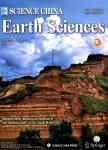Thermodynamic conditions of framework grain dissolution of clastic rocks and its application in Kela 2 gas field
Thermodynamic conditions of framework grain dissolution of clastic rocks and its application in Kela 2 gas field作者机构:China University of Geosciences School of Earth Sciences and Mineral Resources Beijing China Key Laboratory of Lithospheric Tectonics Deep-level Process and Exploration of Ministry of Education Beijing China
出 版 物:《Science China Earth Sciences》 (中国科学(地球科学英文版))
年 卷 期:2005年第48卷第1期
页 面:21-31页
核心收录:
学科分类:081803[工学-地质工程] 08[工学] 0708[理学-地球物理学] 0818[工学-地质资源与地质工程] 0704[理学-天文学]
基 金:Much content and data of this study came from the Fundamental Research Special Support Project of Ministry of Science Technology of China(Grant No.2001CB209104) This work was also supported by the National Natural Science Foundation of China(Grant Nos.49902016 and 40272032)
主 题:dissolution of feldspar, thermodynamic conditions, groundwater pore chemistry, Kela 2 gas field.
摘 要:Feldspar and clastic debris are the most important constituent framework grains of sedimentary clastic rocks and their chemical dissolution plays an essential role in the formation and evolution of the secondary pore in the reservoir rocks. On the basis of thermodynamic phase equilibrium, this study investigates the chemical equilibrium relationships between fluid and various plagioclase and K-feldspar in diagenesis of the sediments, particularly, the impact of temperature and fluid compositions (pH, activity of K+, Na+, Ca2+ and so on) on precipitation and dissolution equilibria of feldspars. Feldspar is extremely easily dissolved in the acid pore water with a low salinity when temperature decreases. The dissolution of anorthite end-member of plagioclase is related to the Ca content of the mineral and the fluid, higher Ca either in the mineral or in the fluid, easier dissolution of the feldspar. Moreover, the dissolution of albite end-member of plagioclase is related to Na of both the mineral and fluid, lower Na out of both the mineral and fluid, easier dissolution of the mineral. Similarly, lower-K fluid is more powerful to dissolve K-feldspar than the higher. The anorthite component of plagioclase is most easily dissolved in ground water-rock system, the albite is the secondary, and K-feldspar is the most stable. Selective dissolution of plagioclase occurs in diagenesis because of the plagioclase solid solution that is mainly composed of albite and anorthite end-members, Ca-rich part of which is preferentially dissolved by the pore water, in contrast to the Na-rich parts. Based on investigation of reservoir quality, secondary pore, dissolution structures of feldspar, clay minerals and ground water chemistry of the Kela 2 gas field of Kuqa Depression in the Tarim basin of Western China, we discovered that the secondary pore is very well developed in the highest quality section of the reservoir, and the plagioclase of which was obviously selectively dissolved, in c



